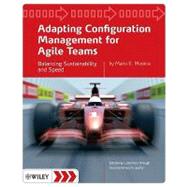
Mario Moreira has been working in the configuration management (CM) field since 1987, and the agile field since 1999. He's a certified ScrumMaster and author of Software Configuration Management Implementation Roadmap published by Wiley in 2004. Mario is also columnist/writer for CM Crossroads, online community and resource for configuration management with 40 articles written to date ranging from topics on CM, Agile requirements engineering to release management.
He has led various agile initiatives with his employer Fidelity Investments as well as leading an agile coaching forum, he is an experienced conference and webinar speaker.
Preface.
Acknowledgements.
About the Author.
Contributor Biography.
1 Introduction: Racing with Confidence.
1.1 Focus of this Book.
1.2 Who should Use this Book.
1.3 Navigation through this Book.
1.4 Value of this Book.
2 CMPrimer.
2.1 Brief History of CM.
2.2 CM Values.
2.3 CM Practices.
2.4 Benefits of CM.
2.5 CM Roles.
2.6 CM Mindset.
2.7 Relationship of CM to Culture, Methods, & Governance.
2.8 CM Resource Guide.
3 Agile Primer.
3.1 Brief History of Agile.
3.2 Agile Values (a.k.a., Manifesto).
3.3 Agile Methods.
3.4 Benefits of Agile.
3.5 Agile Personality Types.
3.6 Agile Roles.
3.7 Agile Mindset.
3.8 Moving to an Agile Culture.
3.9 Agile Resource Guide.
4 How CM and Agile Values Work Together.
4.1 Aligning Agile and CM Mindsets.
4.2 Supporting Agile and CM Values without Sacrifice.
4.3 Value of Retrospective to CM.
4.4 Agile Perspective of CM Practices.
5 Approaching Infrastructure for Agile.
5.1 Guiding Principles for Approaching Infrastructure.
5.2 Considerations for Approaching Infrastructure.
5.3 Infrastructure Envisioning.
5.4 Infrastructure Refactoring.
5.5 Owning on Premises or Renting in the Clouds.
6 Approaching the CM Implementation for Agile.
6.1 CM Envisioning.
6.2 CM Refactoring.
6.3 Automate, Automate, Automate for Agile.
7 Adapting CM Practices for Agile.
7.1 Adapting to Continuous Integration and Build.
7.2 Adapting CM Planning.
7.3 Adapting to Support Refactoring.
7.4 Adapting to Support Pair Programming.
7.5 Adapting to Support Test Driven Development (TDD).
7.6 Adapting to Support Agile Distributed Teams.
7.7 Adapting Change Control, Traceability, and Baselines.
7.8 Adapting CM Audit.
7.9 Adapting Problem Management.
7.10 Adapting CM Report and Review.
8 CM Tool as a Strategic Agile Partner.
8.1 CM Tool Support for Software Development.
8.2 The Agile Practices that Impact a CM Tool.
8.3 Evaluating Your Situation.
8.4 CM Tool Features that Facilitate Agile Development.
8.5 Integration with Your Agile Ecosystem.
8.6 Conclusion.
9 Evaluating Tools Suited for Agile.
9.1 Looking for Tools out there and in here.
9.2 Levels of Technology Evaluation.
9.3 Perform a Technology Evaluation.
10 Using CM Standards and Frameworks to Support Agile.
10.1 Importance of CM.
10.2 Compliance and IT Governance Requirements.
10.3 Communicating Your Approach to Senior Management.
10.4 Which Standards Should Be Considered?
10.5 Configuration Management Functions that are most Essential.
10.6 How do Frameworks such as Cobit, ITIL, CMMI, and RUP support Agile?
10.7 Achieving Synergy through Harmonization and Tailoring.
10.8 Conclusion.
Bibliography.
Index.
The New copy of this book will include any supplemental materials advertised. Please check the title of the book to determine if it should include any access cards, study guides, lab manuals, CDs, etc.
The Used, Rental and eBook copies of this book are not guaranteed to include any supplemental materials. Typically, only the book itself is included. This is true even if the title states it includes any access cards, study guides, lab manuals, CDs, etc.